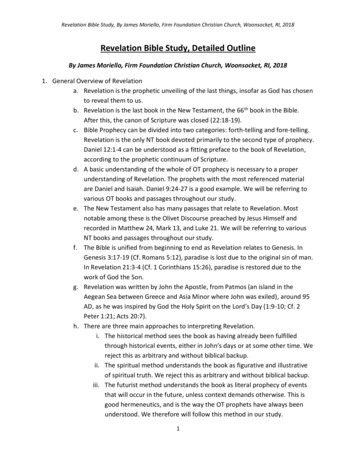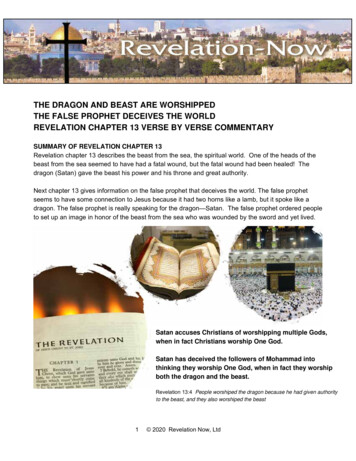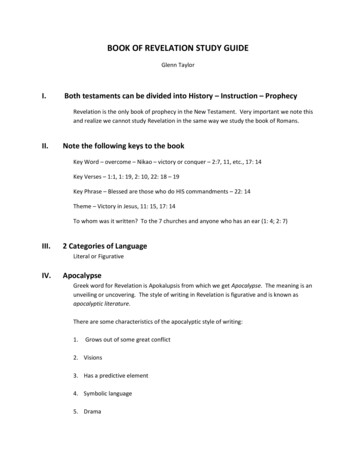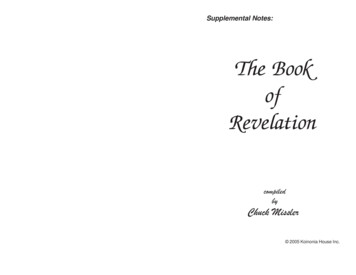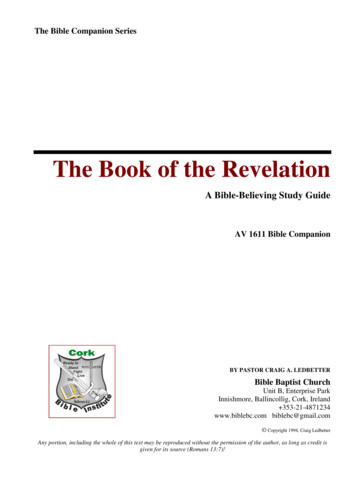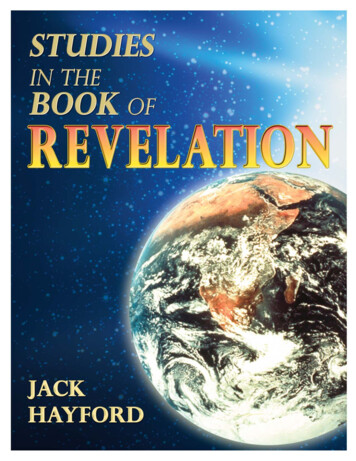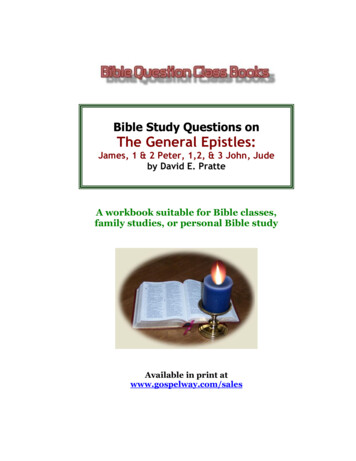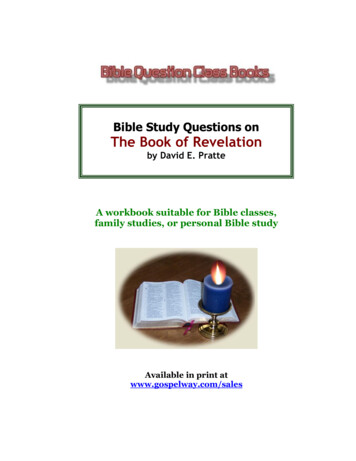
Transcription
Bible Study Questions onThe Book of Revelationby David E. PratteA workbook suitable for Bible classes,family studies, or personal Bible studyAvailable in print atwww.gospelway.com/sales
Bible Study Questions on the Book of Revelation:A workbook suitable for Bible classes, family studies,or personal Bible study Copyright David E. Pratte, 2013, 2014Minor revisions, 2016All rights inted books, booklets, and tracts available atwww.gospelway.com/salesFree Bible study articles online atwww.gospelway.comFree Bible courses online atwww.biblestudylessons.comFree class books atwww.biblestudylessons.com/classbooksFree commentaries on Bible books atwww.gospelway.com/commentaryContact the author atwww.gospelway.com/commentsNote carefully: No teaching in any of our materials is intended or should ever beconstrued to justify or to in any way incite or encourage personal vengeance orphysical violence against any person.“He who glories, let him glory in the Lord”– 1 Corinthians 1:31Front Page PhotoA bay on the island of Patmos; the apostle John was imprisoned on Patmos whenhe wrote the book of Revelation.“I, John, both your brother and companion in tribulation, and in the kingdom andpatience of Jesus Christ, was on the island that is called Patmos for the word ofGod and for the testimony of Jesus Christ.” – Revelation 1:9Photo credit: KF, Nachbearbeitet von Frente distributed under GNU free distribution license,from Wikimedia CommonsScripture quotations are generally from the New King James Version (NKJV), copyright 1982,1988 by Thomas Nelson, Inc. used by permission. All rights reserved.Workbook on RevelationPage #2
Other Books by the AuthorTopical Bible StudiesGrowing a Godly Marriage & Raising Godly ChildrenWhy Believe in God, Jesus, and the Bible? (evidences)The God of the Bible (study of the Father, Son, and Holy Spirit)Grace, Faith, and Obedience: The Gospel or Calvinism?Kingdom of Christ: Future Millennium or Present Spiritual Reign?Do Not Sin Against the Child: Abortion, Unborn Life, & the BibleTrue Words of God: Bible Inspiration and PreservationCommentaries on Bible BooksGenesisJoshua and RuthJudges1 SamuelEzra, Nehemiah, and EstherJobProverbsGospel of MarkGospel of JohnActsRomansEphesiansPhilippians and ColossiansHebrews1 & 2 PeterBible Question Class BooksGenesisJoshua and RuthJudges1 SamuelEzra, Nehemiah, and EstherJobProverbsEcclesiastesIsaiahGospel of MatthewGospel of MarkGospel of LukeGospel of JohnActsRomans1 Corinthians2 Corinthians and GalatiansEphesians and PhilippiansColossians, 1&2 Thessalonians1 & 2 Timothy, Titus, PhilemonHebrewsGeneral Epistles (James - Jude)RevelationWorkbooks with Study NotesJesus Is Lord: Workbook on the Fundamentals of the Gospel of ChristFollowing Jesus: Workbook on DiscipleshipGod’s Eternal Purpose in Christ: Workbook on the Theme of the BibleVisit our website at www.gospelway.com/sales to see a current listof books in print.Page #3Workbook on Revelation
Bible Study Questions on the Book of RevelationIntroduction:This workbook was designed for Bible class study, family study, or personal study. The classbook is suitable for teens and up. The questions contain minimal human commentary, but insteadurge students to study to understand Scripture.Enough questions are included for teachers to assign as many questions as they want for eachstudy session. Studies may proceed at whatever speed and depth will best accomplish the needsof the students.Questions labeled "think" are intended to encourage students to apply what they have learned.When questions refer to a map, students should consult maps in a Bible dictionary or similarreference work or in the back of their Bibles. (Note: My abbreviation "b/c/v" means "book,chapter, and verse.")For class instruction, I urge teachers to assign the questions as homework so students cometo class prepared. Then let class time consist of discussion that focuses on the Scripturesthemselves. Let the teacher use other Scriptures, questions, applications, and comments topromote productive discussion, not just reading the questions to see whether they were answered“correctly.” Please, do not let the class period consist primarily of the following: "Joe, will youanswer number 1?” “Sue, what about number 2?" Etc.I also urge students to emphasize the Bible teaching. Please, do not become bogged downover "What did the author mean by question #5?" My meaning is relatively unimportant. The issueis what the Bible says. Concentrate on the meaning and applications of Scripture. If a questionhelps promote Bible understanding, stay with it. If it becomes unproductive, move on.The questions are not intended just to help students understand the Scriptures. They are alsodesigned to help students learn good principles of Bible study. Good Bible study requires definingthe meaning of keywords, studying parallel passages, explaining the meaning of the text clearly,making applications, and defending the truth as well as exposing religious error. I have includedquestions to encourage students to practice all these study principles.Finally, I encourage plain applications of the principles studied. God's word is written so soulsmay please God and have eternal life. Please study it with the respect and devotion it deserves!For whatever good this material achieves, to God be the glory.You can find Bible study commentary and notes to accompany many of our BibleQuestion Class Books at www.gospelway.com/sales David E. Pratte, June 21, 2017Workbooks, commentaries, and topical studies for sale in print atwww.gospelway.com/salesTo join our mailing list to be informed of new books or special sales, contact theauthor at www.gospelway.com/commentsWorkbook on RevelationPage #4
Assignment: Introduction to RevelationRead the whole book of Revelation at least once (or more). Before reading the book,look over the following questions and then answer the questions as you read.1. Who wrote the book (give b/c/v)?2. To whom was the book addressed?3. Make a list of verses containing phrases or words that indicate that the message of the bookis largely symbolism (verses that use words such as “like,” “as,” “sign,” “signify,” etc.).4. Make a list of references that describe or refer to the circumstances/situation faced by theChristians to whom the book was written (include b/c/v).5. Make a list of references discussing conflict between good and evil and especially thosedescribing the victory of Christ and good over Satan and evil (include b/c/v).Page #5Workbook on Revelation
6. Begin a list of passages that indicate who the enemy is that Christians were facing – whowas persecuting them, with whom did they have conflict, etc.? (Note: as we study the book add tothis list and to the lists in the above assignments.)7. Summarize the theme of the book. (How do you expect the book to benefit you?)8. Based on the above information, make a list of principles or guidelines that would help usin our study of this book.9. Special Assignment: From whatever sources you may consult, make a list of alternativegeneral viewpoints (“interpretations”) of Revelation.10. Special Assignment: Summarize the doctrine of premillennialism and list Scripturalobjections to it.Note: While you may wish to consult commentaries or similar sources as we study, suchhuman sources should not be accepted as authority in class (“don’t even think about it”). Thisis a study of the Bible. However, we may refer to such materials briefly from time to time in orderto understand what different views people hold or to refute them.Workbook on RevelationPage #6
Assignments on Revelation 1Please read Revelation 1 and answer the following questions.1. Define “revelation” – 1:1 (Note the word is singular, not plural.) (Think: In what sense isthis book a revelation?)2. From whom did the message come, and what is the purpose of the message?3. Special Assignment: List expressions elsewhere showing the message is about things“shortly” or soon to occur. Lessons?4. What inspired author recorded the message? Where else is he named in the book?5. How did he receive the message, and what did he do with it – 1:1,2? (Note the claim toinspiration.)6. Special Assignment: Define “signify.” List other places where the word is used. Whereis “sign” used in Revelation? Lessons?7. To whom is the message addressed, and what should they (and we) do with it – 1:3,4? (Note:“the time is near.”) (Think: Why address only 7 churches?)8. How is God described in v4? List similar b/c/v.Page #7Workbook on Revelation
9. List other passages regarding the seven spirits. (Think: What is the significance of thenumber 7?)10. Where else is God mentioned in chap. 1? Where else is Jesus mentioned in chap. 1? (Think:What is the significance of “seven Spirits”?)11. How is Jesus described in 1:5? In what sense is He the firstborn from the dead?12. List other passages showing He is above all kings.13. What has He done for us – 1:5,6? List other passages regarding the importance of Hisblood.14. In what sense are we priests? Give other b/c/v.15. What will happen when He comes – 1:7? (Think: Does this coming refer to the finaljudgment or coming in some other sense? Proof?)16. How is the Lord described in 1:8? Explain the phrases used (see other b/c/v). (Think:Does this refer to the Father, the Son, or Deity in general?)Workbook on RevelationPage #8
17. What did John share in common with those to whom he wrote – 1:9?18. Special Assignment: List other passages showing Christians in the first century werein the kingdom. How does this disprove premillennialism?19. Where was John when he wrote (see a map)? Why was he there?20. When did he receive the Revelation – 1:10? What does this mean? (Think: In what sensewas he “in the Spirit”?)21. What did John hear (v10)? What did the voice say (v11)?22. List the churches to whom Revelation is addressed. (Think: Did John and other Biblewriters write just because they thought it was a good idea? Lessons?)23. Where did the One like the Son of Man stand – 1:12,13? What do the lampstandsrepresent?24. Describe His personal appearance – 1:13-16. What is the point?Page #9Workbook on Revelation
25. How did His voice sound (cf. vv 10,15)? Explain.26. What was in His hand – 1:16? What does this represent?27. What came from His mouth? Give other b/c/v and explain.28. Describe the appearance of His face. Give similar b/c/v and explain the significance.29. How did this affect John – 1:17? What reassurance was he given?30. How did the speaker describe Himself – 1:17,18? Explain each phrase and compare toother similar passages. (Think: Who does this prove the Speaker to be, and what does it proveabout Him?)31. What was John to write about – 1:19?32. Explain the 7 lampstands – 1:20. In what way is this a helpful illustration?33. Explain the 7 stars. What is the significance of churches having angels (messengers)?Workbook on RevelationPage #10
Assignments on Revelation 2Please read Revelation 2 and answer the following questions.1. Special Assignment: Skim chap. 2&3. Write a summary of the general pattern Jesusfollowed in addressing each of the churches.2. How does Jesus describe Himself to the first church – 2:1?3. Special Assignment: List some things we know from other passages about the city andthe church of Ephesus.4. What did Jesus know about the church – 2:2? What does this show about them and aboutHim?5. List other passages regarding false teachers. What is our duty toward them?6. What had the Ephesians done for Jesus – 2:3? List other passages.7. What did Jesus have against the church – 2:4,5? What must they do about it, and what werethe consequences? Explain lessons for us.8. Whose specific error had the Ephesian church opposed – 2:6? Where else is this errormentioned? (Think: What did this error involve?)9. Case Study: Suppose someone claims that we please God so long as we simply do notpersonally participate in sin, and nothing more is required. How should you respond?Page #11Workbook on Revelation
10. Explain the concept of overcoming as used in Revelation – 2:7.11. What reward did Jesus promise overcomers? Give other b/c/v and explain.12. How does Jesus describe Himself to Smyrna – 2:8? Give other b/c/v.13. What else do we know about the city and church of Smyrna?14. What did Jesus know about the church – 2:9? Explain “poverty” and “rich.”15. Describe the suffering they had and would face – 2:10. From whom did this come? Explainthe description of these people. (Think: What is the significance of the 10 days?)16. What is required of those who suffer for Christ (v10)? Explain.17. What reward is offered to overcomers – 2:11? Give other b/c/v and explain.18. What criticism did Jesus have of the Smyrna church? What can we learn?Workbook on RevelationPage #12
19. How did Jesus describe Himself to the church at Pergamos – 2:12?20. What do we know about the city and church at Pergamos?21. What external problems did the church there face – 2:13?22. How did they respond to these problems?23. Tell the story of Balaam (2:14), and give b/c/v.24. What application did this have to the church at Pergamos? What can we learn? (Think:What does this show about the external problems the church faced?)25. What other false doctrine did Pergamos face – 2:15? What do we know about it?26. What did Jesus expect them to do about these doctrines – 2:16? What were theconsequences?27. What can we learn about our response toward doctrines that lead people into sin?28. What blessings are promised to overcomers – 2:17? Explain them (check other b/c/v, ifpossible).Page #13Workbook on Revelation
29. How did Jesus identify Himself to the church in Thyatira – 2:18? What do we know aboutthis city and church?30. What did Jesus know about them – 2:19? Specifically, what did He know about theirworks? (Think: What previous church does this contrast to? What can we learn?)31. What problem did Thyatira have – 2:20? What other church is this like?32. What do we know about Jezebel? How was she like this case?33. Special Assignment: How might modern churches have problems like Thyatira?34. What had God done about her, and what did He intend to do – 2:21-23? (Think: What canwe learn about God’s grace, longsuffering, and justice?)35. What can we learn about God’s judgment of our lives?36. What message did Jesus give those who had not accepted these doctrines – 2:24,25?37. Case Study: How would you respond if someone says: “Don’t get hung up on doctrine.Don’t major in patterns and authority, but just accomplish good work for the Lord”?38. What did Jesus promise to overcomers – 2:26-29? What passage did He quote? Howdoes that help explain His promise? (Think: What is the morning star? Cf. other b/c/v.)Workbook on RevelationPage #14
Assignments on Revelation 3Please read Revelation 3 and answer the following questions.1. How did Jesus introduce Himself to Sardis – 3:1? What is known about the church and citythere?2. What problems existed at Sardis – 3:2?3. Explain “dead” and “alive” as used here. Give other b/c/v. (Think: Other churches facedpersecution. What persecution is mentioned regarding this church? Lessons?)4. What did He command them to do about their problems – 3:2,3?5. What would happen if they did not repent?6. What is meant by coming as a thief? Give other b/c/v.7. Was everyone at Sardis guilty – 3:4? What promise is given to the faithful?8. Special Assignment: Must we always leave a congregation where sin exists? Why couldsome at Sardis be accepted, yet other whole congregations are rebuked?Page #15Workbook on Revelation
9. What is promised to overcomers – 3:5? Explain the significance of white garments.10. What is the Book of Life? Give other b/c/v. What is the significance of being blotted outof the book?11. Give other passages about being confessed before God.12. What do we know about the church and city of Philadelphia – 3:7?13. How did Jesus describe Himself to them? In what sense is He holy? True?14. What key did Jesus have? What verse is referred to here? Explain the significance.15. What had Jesus opened for Philadelphia – 3:8? Explain.16. In what way did He commend them?Workbook on RevelationPage #16
17. Where have we read of a synagogue of Satan – 3:9? What would God make them do?Explain. What can we learn? (Think: Would they worship the Christians or worship God in theirpresence? Cf. Isaiah 45:14; 49:23.)18. What command had they kept, and what would result – 3:10?19. What criticism did Jesus have of them? What other church was similar? Lessons?20. What should they do to be ready for His coming – 3:11?21. What reward is promised overcomers – 3:12? What is the significance of being a pillar inthe temple?22. What would be written on them? Give other b/c/v. Explain.23. How did Jesus describe Himself to Laodicea – 3:14? What else do we know about the cityand church of Laodicea?24. Special Assignment: In what sense is Jesus the beginning of creation? Was He the firstthing created or the source of creation? Give other b/c/v. (Think: What are the consequences ofthis question?)Page #17Workbook on Revelation
25. What problem did Laodicea have – 3:15,16? Explain “cold” and “hot” as used here.26. What conclusion did Jesus reach regarding this problem? What applications can wemake?27. What did the Laodiceans think of themselves – 3:17? What were they really like? Whatother church does this compare to?28. What did Jesus offer to do for them – 3:18? What blessings could He give? Explain.(Think: What can we learn regarding nakedness? What does this word mean in the Bible?)29. Why did Jesus speak as He did to them – 3:19? What must they do to correct theirproblems?30. Special Assignment: What should we learn about rebuke and chastening? Do we everneed it? Should we ever practice it?31. Explain the illustration of Jesus at the door – 3:20. (Think: Does this apply to alien sinnersor also to church members?)32. What blessing is offered to overcomers – 3:21? Where else are similar ideas expressed?Explain.Workbook on RevelationPage #18
Assignments on Revelation 4Please read Revelation 4 and answer the following questions.1. What did John see next – 4:1? (Think: What is the significance of an open door?)2. What did he hear? What did it sound like (cf. other similar examples)? What was said?3. What did He see in Heaven – 4:2? Who is the One on the throne (note v8)? (Think: Whathave we learned about “in the Spirit”?)4. List other passages that describe God on His throne.5. How is the One on the throne described – 4:3? What is known of these stones? What is thepoint?6. What surrounded the throne – 4:4? Who sat there? Where else are they mentioned?7. Describe their appearance. Explain. (Think: What do these represent?)8. What came from the throne– 4:5? Give other b/c/v and explain the significance.9. What was before the throne in v5? What did they represent? Where else have we read ofthem?Page #19Workbook on Revelation
10. What else was before the throne – 4:6? Give other b/c/v. (Think: What does the searepresent?)11. What did John see in the midst and around the throne? Where else are these creaturesmentioned?12. What kinds of creatures were there – 4:7-9? What is meant by being full of eyes?13. What do these creatures do? What does this show about God?14. Special Assignment: Discuss alternative views of what these creatures represent.15. What do the 24 elders do when the creatures worship God – 4:10,11? (Think: What is thesignificance of casting their crowns?)16. What does God deserve to receive? Explain the terms used.17. List other passages about creation and discuss why creation proves God deservesworship.18. Special Assignment: What lessons should we learn from this context about the purposeand importance of worship?19. What can we learn about the overall theme and purpose of the book of Revelation?Workbook on RevelationPage #20
Assignments on Revelation 5Please read Revelation 5 and answer the following questions.1. Special Assignment: Read Daniel chap. 7 (see also Dan. 2; Luke 24:50-53; Acts 1:6-12).As you study, list as many parallels as you can between Dan. 7 and Rev. 4&5.2. What was in the hand of the One on the throne – 5:1? (Think: What is the significance ofbeing in His right hand and being written on both sides?)3. Why could it not be read – 5:2,3? Give b/c/v and explain the significance of seals. (Think:What does the scroll contain? I.e., what is the significance of its contents?)4. What problem was raised by a strong angel? Who responded at first to the call (v3), andhow did this affect John – 5:4?5. What information did one of the elders give John – 5:5?6. Explain the expressions used to describe the person in v5, and give b/c/v for other suchverses.7. When John looked what did He see – 5:6 (cf. to the description of v5)? List other passagessimilarly describing Jesus. (Think: How can Jesus be both a lion and a lamb?)8. What had happened to the Lamb? Yet was it dead or alive? Explain the significance.9. Explain the 7 horns and 7 eyes.10. Where does the Lamb stand? What does this prove?Page #21Workbook on Revelation
11. Explain what this scene refers to. How does it fit God’s overall plan?12. What did the Lamb do – 5:7? What is the significance of this compared to vv 2-5?13. What happened when He did this – 5:8?14. What do the elders have? What do the bowls of incense represent?15. Case Study: List other references to harps in Revelation. If someone argued that thisproves we can use instrumental music in worship on earth, how would you respond?16. Describe the song they sing – 5:9,10. Why was the blood of the Lamb important?17. Define “redeem.” Give other b/c/v about redemption by the blood.18. Who can be redeemed by the blood? Lessons?19. Who then joined in the song of praise – 5:11?20. Define each thing the Lamb is worthy to receive – 5:12.21. Who then joins the chorus – 5:13,14? Summarize in your own words the significance of thechapter.Workbook on RevelationPage #22
Assignments on Revelation 6Please read Revelation 6 and answer the following questions.1. Describe what John saw when the first seal was opened – 6:1,2. What other passages maybe similar?2. Explain the significance of the symbols: white horse, bow, crown.3. What could this rider represent?4. Describe what John saw when the second seal was opened – 6:3,4.5. Explain what this rider represents.6. Describe what John saw when the third seal was opened – 6:5,6.7. Explain the significance of the symbols: black horse, scales, denarius.8. What would this rider represent?9. Describe what John saw when the fourth seal was opened – 6:7,8.10. Who rode this horse, and what methods did it use? What does Hades refer to?Page #23Workbook on Revelation
11. Explain the significance of this rider.12. What did John see when the fifth seal was opened – 6:9-11? (Think: What would be themeaning of the slain souls being at the base of the altar? Cf. Old Testament sacrifices.)13. What did they request? List other similar passages. (Think: Why would they call God“holy and true”?)14. Explain how this relates to the theme of Revelation. (Think: Is this what people wouldnaturally expect to follow after the glorious visions of chap. 4,5?)15. What was given to them? Explain the significance.16. What were they told? What lessons and conclusion does this lead to? Are God’s promisesfailing? (Think: Does this help explain the significance of seals 2-4?)17. What happened when the sixth seal was opened – 6:12-14? List other passages withsimilar expressions. (Think: Do such expressions necessarily refer to the final end of the wholeearth? Explain.)18. What effect did these events have on people – 6:15? Explain.19. What did they want the mountains and rocks to do – 6:16? Why? Give similar b/c/v.20. Special Assignment: Explain the main point of chap. 6 and its relationship to chap.4&5. How does v17 help us understand this?Workbook on RevelationPage #24
Assignments on Revelation 7Please read Revelation 7 and answer the following questions.1. Where were four angels standing whom John saw next – 7:1? What were they doing?2. What power had been granted to these angels – 7:2? List other passages where wind refersto God’s punishment on evil people.3. When an angel came from the east, what did he have? What have we learned about thesignificance of a seal (b/c/v)?4. What was going to be sealed and where – 7:3? Give similar passages about theidentification of people in Revelation or elsewhere.5. What had to wait till this seal was applied? Explain the significance of sealing here. Howdoes it fit with chap. 4-6, especially 6:17?6. How many were sealed – 7:4-8? What did this number consist of? Where else are theymentioned?7. What is the significance of the numbers 12 and 1000 in Bible symbols? Examples? (Notethat 144,000 12x12x1000.)8. Is this number literal? List other symbols in the context. Are the children of Israel literalhere?9. Case Study: What do Jehovah’s Witnesses claim the 144,000 and the great multituderepresent? How can you disprove their view?10. Explain the significance of the 144,000 in contrast to the great multitude of vv 9ff.Page #25Workbook on Revelation
11. Describe the characteristics of the great multitude – 7:9. Where did they stand? How werethey clothed?12. Explain the symbols used in the description.13. Contrast the great multitude to the 144,000.14. What did the great multitude do – 7:10? List similar b/c/v.15. Who joined in the praise – 7:11,12? Where else have they praised God?16. What question did an elder ask – 7:13,14? How did he answer his question?17. List other verses about the Lamb’s blood. (Think: What is the great tribulation?)18. Where was the great multitude and what did they do according to 7:15?19. What blessings did they receive – 7:16? Give other b/c/v.20. What did the Lamb and God do for them – 7:17? Give other b/c/v.21. Special Assignment: What conclusions do you reach about who the great multitudemay be? Defend your answer.Workbook on RevelationPage #26
Assignments on Revelation 8Please read Revelation 8 and answer the following questions.1. What happened when the 7th seal was first opened – 8:1? What is the significance?2. What were 7 angels given – 8:2? What is the significance of trumpets?3. What did the angel with the golden censer do – 8:3,4? What purpose did the golden altarserve in the Old Testament?4. Where else have we read of prayers of saints? How does this relate to chap. 8?5. What did the angel do with the fire from the altar – 8:5? What was the result? Explain.6. What happened when the first trumpet sounded – 8:6,7? What harm followed? (Think:What is the significance of 1/3?)7. What happened when the 2nd trumpet sounded – 8:8,9? What harm followed? (Think: Whatis the significance of mountains in prophecy?)8. What happened when the 3rd trumpet sounded – 8:10,11? What is wormwood? What harmfollowed? (Think: What is the significance of stars in prophecy?)9. What happened when the 4th trumpet sounded – 8:12?10. What message did a flying angel deliver – 8:13? Define “woe.” What is the significance ofrepeating it? To what did the woes refer?Page #27Workbook on Revelation
Assignments on Revelation 9Please read Revelation 9 and answer the following questions.1. What happened when the fifth trumpet sounded – 9:1? What do stars often represent?Where else do we read of something/someone falling from heaven?2. What power was given to him – 9:2? What does a key represent? What is the abyss(bottomless pit) – give other b/c/v?3. Special Assignment: What does this star represent? Who has the key of the bottomlesspit? Note v11. Explain the significance.4. What happened when he opened the pit? Give similar b/c/v. Explain. (Think: Note in thissection the numerous words expressing symbolism: “like,” “as,” etc.)5. What came from the smoke – 9:3? Give similar b/c/v. What could they hurt and not hurt?(Think: Who is the source of this harm? Lessons?)6. What harm did they do – 9:4,5? For how long? Explain.7. What is a scorpion? How does it do damage? How did this affect the people – 9:6?Workbook on RevelationPage #28
8. Describe the appearance of the locusts – 9:7,8. Explain the symbols.9. Special Assignment: What significance is there that: (1) Their crowns are “like” gold(but not real gold); and (2) Their hair is like women’s hair?10. Describe their breastplates and tails and the sound they made – 9:9,10. Explain.11. Who led them – 9:11? Define “Abaddon”/”Apollyon.” Explain.12. Which woe is this – 9:12? How many woes are there? Give other b/c/v.13. Special Assignment: What is the meaning of this woe and the locusts, etc.? To whatdoes this all refer, and what application can we make?14. What did John hear when the sixth angel sounded – 9:13,14? Where have we read aboutthe golden altar, and what is its significance here?Page #29Workbook on Revelation
15. Where are the four angels – 9:14? Where else do we read of this river? What great empiresfrom this area attacked Old Testament Israel?16. What happened when the four angels were released – 9:15? What is the significance of1/3? (Think: Where else have we read of four angels that withheld destruction till the propertime?)17. What did John see and hear coming – 9:16? How many were there? (Think: What is thesignificance of this number?)18. Describe the horsemen – 9:17. Consider the colors of their breastplates (cf. NKJV &NASB), and compare them to the destruction from the horses’ mouths.19. How else did the horses cause harm – 9:18,19? What was the end result on the people?20. What happened to those who were not killed – 9:20? How is their worship described?21. List and explain the sins they committed – 9:21. (Think: Would this describe Jews or morelikely Gentiles?)22. Special Assignment: Consider what evil people are here referred to. Where did theylive, when did this happen, etc.?Workbook on RevelationPage #30
Ass
Page #5 Workbook on Revelation Assignment: Introduction to Revelation Read the whole book of Revelation at least once (or more). Before reading the book, look over the following questions and then answer the questions as you read. 1. Who wrote the


